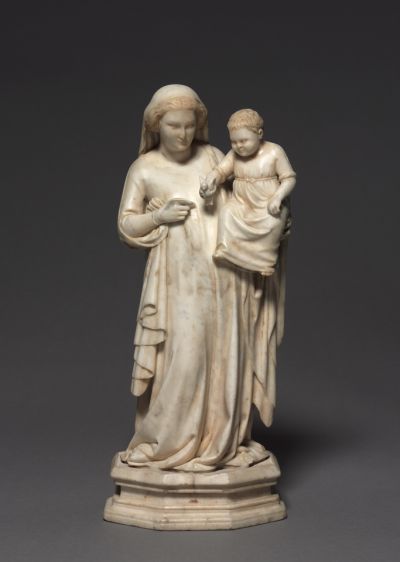The Italian Renaissance had its birth in Florence, a prosperous medieval banking and mercantile center. Well-known are the names of the artists who flourished there: Giotto, Donatello, Botticelli, Leonardo, and Michelangelo, the stars of today’s art history books. The galleries of the Cleveland Museum of Art are filled with works that connect us to this celebrated city at this pivotal moment in its history. One object, a small, highly-polished marble statuette of the “Madonna and Child” offers the viewer a link to two major monuments of Florence, the famed Duomo, or cathedral, and its Baptistery. The modern tourist to Florence inevitably starts with a visit to these wondrous emblems of the Florentine Renaissance. The Duomo, with its masterpiece, Brunelleschi’s dome, can be seen from all over the city and has been called essential to the Florentine sense of self.
At the geographical and spiritual heart of the city, just opposite the Duomo, lay the Baptistery, Dante’s “il mio bel San Giovanni,” named for John the Baptist, who from the early Middle Ages was the patron saint of the city. While Florence had more than 50 parish churches, all children were brought to the Baptistery for what was, in effect, a double baptism, as a Christian and as a Florentine. After 1336, the family entered the south portal, facing the cathedral, through a magnificent set of new bronze doors by Andrea Pisano (ca. 1290-1348) whose relief panels represented the life of John the Baptist.
The statuette of the Madonna, now in Cleveland, is thought to be by the hand of the same artist, most likely made during the period in which Pisano worked on his famous bronze doors. Pisano, as his name implies, was born near Pisa. He eventually settled in Florence where his chief works were produced and where he assisted Giotto (1267-1337) on the construction of the cathedral. Pisano was much influenced by the art of Giotto who was then officially Master of the Works of the Duomo. The campanile next to the Duomo is a design of Giotto’s. When Giotto died in 1337, Andrea Pisano succeeded him in this position and continued work on the building until it was again halted by the arrival of the Black Death in 1348.
Andrea Pisano, while living in Florence, produced many important works in marble sculpture. His small statuette of the Madonna in the Cleveland Museum of Art is made from cream-colored, fine-grained and highly polished marble. It stands about 15 inches in height and is without doubt one of the most beautiful sculptures that still exist by this artist. It is believed to be the only sculpture by Andrea Pisano in a U.S. collection. The Madonna is represented in the standing position. She cradles her son in her left arm. Both mother and son look pensively at an object held by the child, a small bird, perhaps a goldfinch, a symbol of the human soul. By extension, the symbol suggests that Christ is the redeemer of humankind. The mother’s head, hair and veil form a particularly beautiful composition. Originally, the hair of both mother and child were gilded. Today, only traces of gold remain, but enough to suggest the striking appearance of the sculpture when new.
The small scale of our “Madonna and Child” by Andrea Pisano indicates that it was not produced for public veneration within a large building such as a church. Larger sculptures were typically made for viewing at a distance in churches. Instead, it was undoubtedly made for private, more intimate, veneration within a home or a private chapel. Who commissioned this sculpture? This remains undocumented and we will likely never know. Our Madonna may have belonged to a well-to-do Florentine family or a high-ranking civic official who cherished it for private prayer. Were candles lit before her? How was she displayed; within a wall niche or on table or stand? Could she have been used by one of the many religious orders within Florence at the time: the Augustinians, the Dominicans, the Carmelites? Perhaps she once stood within the confines of the cell of a monk or nun, where she formed the visual focus of prayer and private veneration.
Christian images had an important place in the Florentine home. In the 14th century, the Dominican Giovanni Dominici (1357-1419) encouraged parents to instill good religious behavior in their children by means of pictures, statues or toys. At an early age, a child could adore the Christ Child and his mother and as a girl grew her character would be formed by the contemplation of female saints. Dominici even recommended a play altar where a child (presumably male) could imitate a priest. Images of the “Madonna and Child,” either paintings or sculptures, were common in the Florentine home and in some houses were placed in every room. The marble material, gilded details and beautiful finish of Pisano’s Madonna would suggest she was an expensive commission and destined for use by a patron of wealth.
Made during the 1330s, our statuette represents the pinnacle of Andrea Pisano’s artistic career during which he collaborated with the esteemed Giotto on the Duomo and during which he produced his great masterpiece, the bronze doors for the south portal of the Baptistery. From Florence, Pisano would go on to become Master of the Works at Orvieto Cathedral in 1447. His beautiful “Madonna and Child,” now in the Cleveland Museum of Art, provides us with an artistic and historical connection to this wonderfully creative period in the history of Renaissance Florence.



